Determinants of Healthcare in United States: An Analysis
VerifiedAdded on 2020/05/11
|5
|894
|194
Report
AI Summary
This report provides an in-depth analysis of the US healthcare system, focusing on the determination of healthcare standards and their impact on health outcomes. It examines the unique characteristics of the US system compared to other industrialized countries, including the absence of a universal Medicare system and the hybrid funding model. The report delves into the factors influencing healthcare costs, disparities in the insurance system, and the influence of policies like the Affordable Care Act. It also discusses the role of various organizations in shaping healthcare policies and proposes the development of policies involving risk management, quality improvement, and equitable care. The paper references key studies and data to support its arguments and offers insights into improving healthcare delivery within an organizational context.
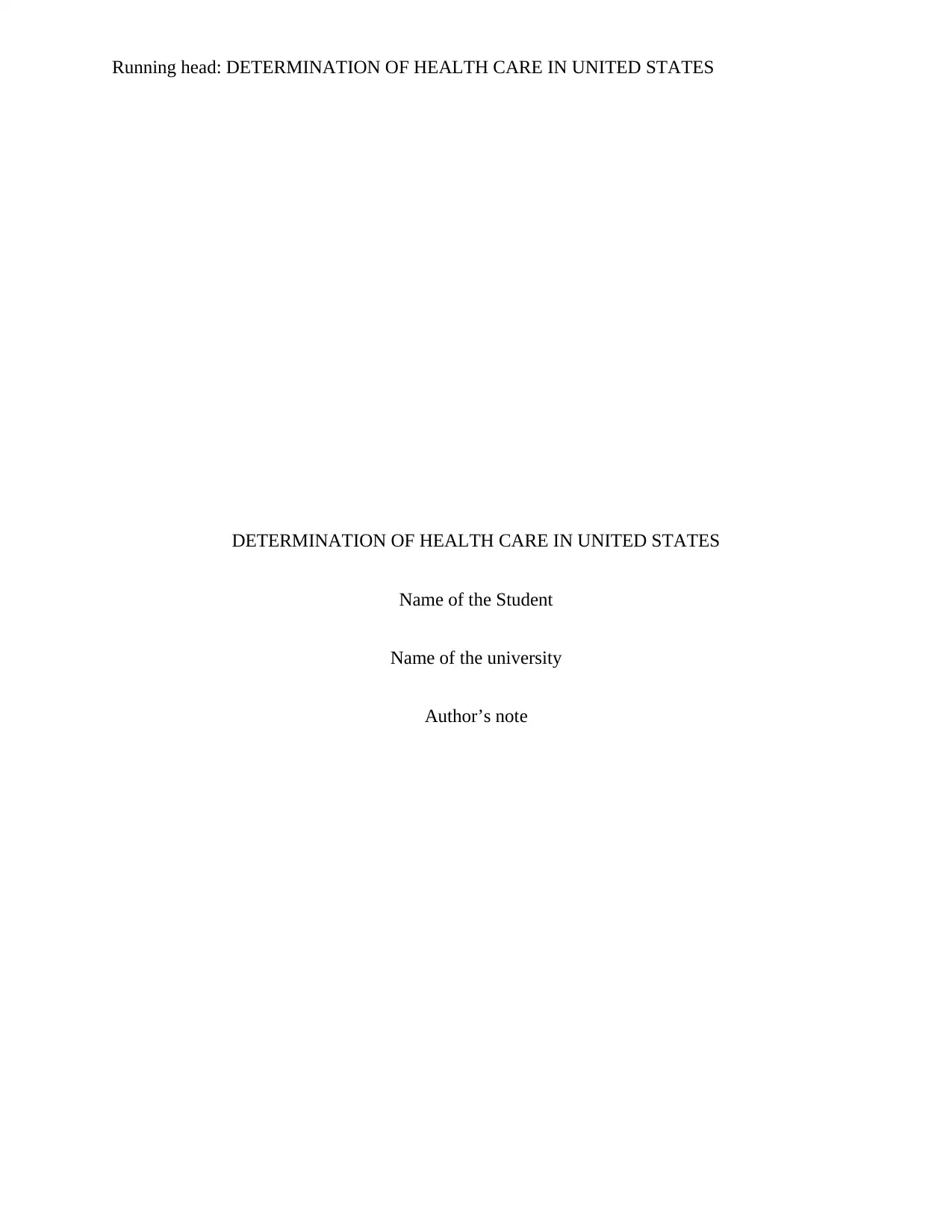
Running head: DETERMINATION OF HEALTH CARE IN UNITED STATES
DETERMINATION OF HEALTH CARE IN UNITED STATES
Name of the Student
Name of the university
Author’s note
DETERMINATION OF HEALTH CARE IN UNITED STATES
Name of the Student
Name of the university
Author’s note
Paraphrase This Document
Need a fresh take? Get an instant paraphrase of this document with our AI Paraphraser
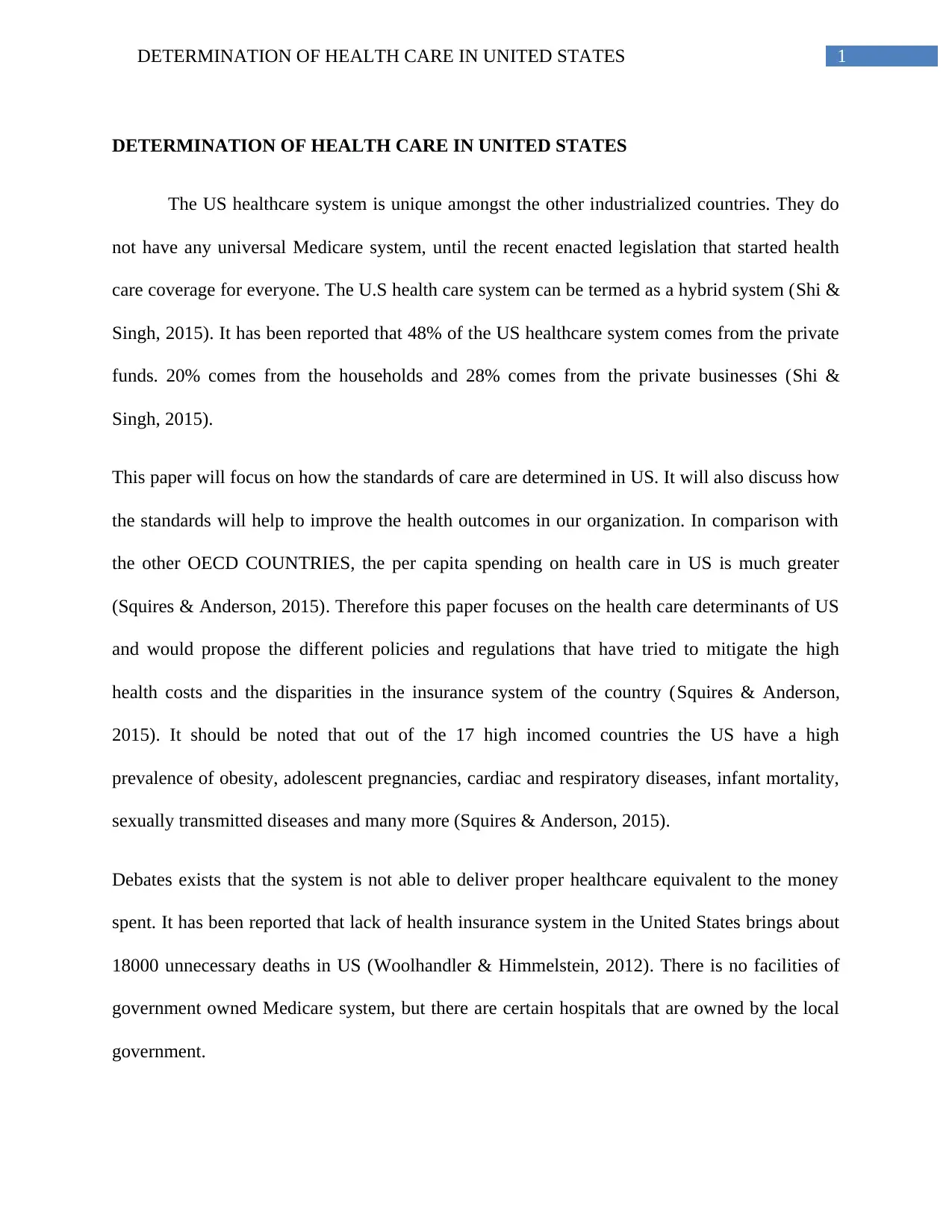
1DETERMINATION OF HEALTH CARE IN UNITED STATES
DETERMINATION OF HEALTH CARE IN UNITED STATES
The US healthcare system is unique amongst the other industrialized countries. They do
not have any universal Medicare system, until the recent enacted legislation that started health
care coverage for everyone. The U.S health care system can be termed as a hybrid system (Shi &
Singh, 2015). It has been reported that 48% of the US healthcare system comes from the private
funds. 20% comes from the households and 28% comes from the private businesses (Shi &
Singh, 2015).
This paper will focus on how the standards of care are determined in US. It will also discuss how
the standards will help to improve the health outcomes in our organization. In comparison with
the other OECD COUNTRIES, the per capita spending on health care in US is much greater
(Squires & Anderson, 2015). Therefore this paper focuses on the health care determinants of US
and would propose the different policies and regulations that have tried to mitigate the high
health costs and the disparities in the insurance system of the country (Squires & Anderson,
2015). It should be noted that out of the 17 high incomed countries the US have a high
prevalence of obesity, adolescent pregnancies, cardiac and respiratory diseases, infant mortality,
sexually transmitted diseases and many more (Squires & Anderson, 2015).
Debates exists that the system is not able to deliver proper healthcare equivalent to the money
spent. It has been reported that lack of health insurance system in the United States brings about
18000 unnecessary deaths in US (Woolhandler & Himmelstein, 2012). There is no facilities of
government owned Medicare system, but there are certain hospitals that are owned by the local
government.
DETERMINATION OF HEALTH CARE IN UNITED STATES
The US healthcare system is unique amongst the other industrialized countries. They do
not have any universal Medicare system, until the recent enacted legislation that started health
care coverage for everyone. The U.S health care system can be termed as a hybrid system (Shi &
Singh, 2015). It has been reported that 48% of the US healthcare system comes from the private
funds. 20% comes from the households and 28% comes from the private businesses (Shi &
Singh, 2015).
This paper will focus on how the standards of care are determined in US. It will also discuss how
the standards will help to improve the health outcomes in our organization. In comparison with
the other OECD COUNTRIES, the per capita spending on health care in US is much greater
(Squires & Anderson, 2015). Therefore this paper focuses on the health care determinants of US
and would propose the different policies and regulations that have tried to mitigate the high
health costs and the disparities in the insurance system of the country (Squires & Anderson,
2015). It should be noted that out of the 17 high incomed countries the US have a high
prevalence of obesity, adolescent pregnancies, cardiac and respiratory diseases, infant mortality,
sexually transmitted diseases and many more (Squires & Anderson, 2015).
Debates exists that the system is not able to deliver proper healthcare equivalent to the money
spent. It has been reported that lack of health insurance system in the United States brings about
18000 unnecessary deaths in US (Woolhandler & Himmelstein, 2012). There is no facilities of
government owned Medicare system, but there are certain hospitals that are owned by the local
government.
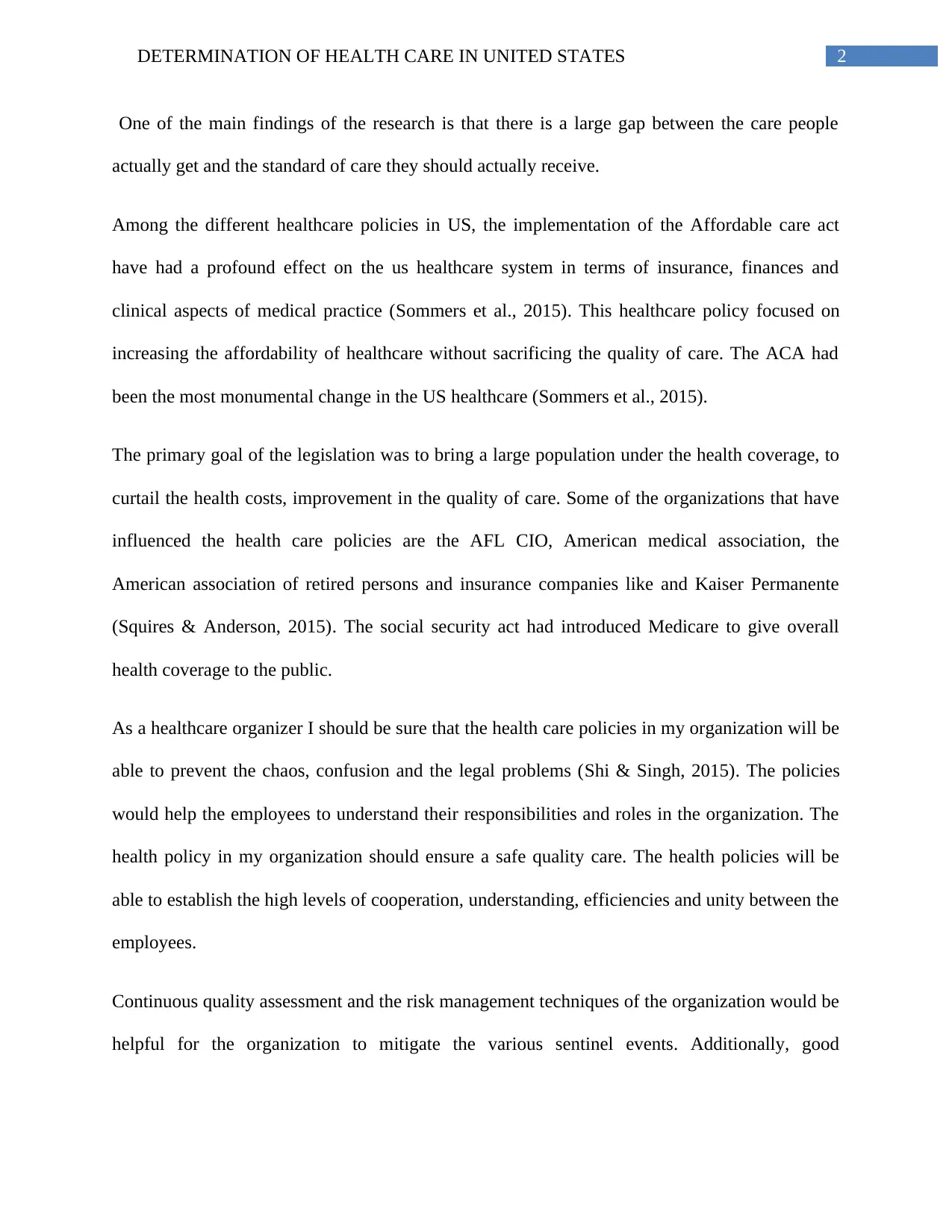
2DETERMINATION OF HEALTH CARE IN UNITED STATES
One of the main findings of the research is that there is a large gap between the care people
actually get and the standard of care they should actually receive.
Among the different healthcare policies in US, the implementation of the Affordable care act
have had a profound effect on the us healthcare system in terms of insurance, finances and
clinical aspects of medical practice (Sommers et al., 2015). This healthcare policy focused on
increasing the affordability of healthcare without sacrificing the quality of care. The ACA had
been the most monumental change in the US healthcare (Sommers et al., 2015).
The primary goal of the legislation was to bring a large population under the health coverage, to
curtail the health costs, improvement in the quality of care. Some of the organizations that have
influenced the health care policies are the AFL CIO, American medical association, the
American association of retired persons and insurance companies like and Kaiser Permanente
(Squires & Anderson, 2015). The social security act had introduced Medicare to give overall
health coverage to the public.
As a healthcare organizer I should be sure that the health care policies in my organization will be
able to prevent the chaos, confusion and the legal problems (Shi & Singh, 2015). The policies
would help the employees to understand their responsibilities and roles in the organization. The
health policy in my organization should ensure a safe quality care. The health policies will be
able to establish the high levels of cooperation, understanding, efficiencies and unity between the
employees.
Continuous quality assessment and the risk management techniques of the organization would be
helpful for the organization to mitigate the various sentinel events. Additionally, good
One of the main findings of the research is that there is a large gap between the care people
actually get and the standard of care they should actually receive.
Among the different healthcare policies in US, the implementation of the Affordable care act
have had a profound effect on the us healthcare system in terms of insurance, finances and
clinical aspects of medical practice (Sommers et al., 2015). This healthcare policy focused on
increasing the affordability of healthcare without sacrificing the quality of care. The ACA had
been the most monumental change in the US healthcare (Sommers et al., 2015).
The primary goal of the legislation was to bring a large population under the health coverage, to
curtail the health costs, improvement in the quality of care. Some of the organizations that have
influenced the health care policies are the AFL CIO, American medical association, the
American association of retired persons and insurance companies like and Kaiser Permanente
(Squires & Anderson, 2015). The social security act had introduced Medicare to give overall
health coverage to the public.
As a healthcare organizer I should be sure that the health care policies in my organization will be
able to prevent the chaos, confusion and the legal problems (Shi & Singh, 2015). The policies
would help the employees to understand their responsibilities and roles in the organization. The
health policy in my organization should ensure a safe quality care. The health policies will be
able to establish the high levels of cooperation, understanding, efficiencies and unity between the
employees.
Continuous quality assessment and the risk management techniques of the organization would be
helpful for the organization to mitigate the various sentinel events. Additionally, good
⊘ This is a preview!⊘
Do you want full access?
Subscribe today to unlock all pages.

Trusted by 1+ million students worldwide
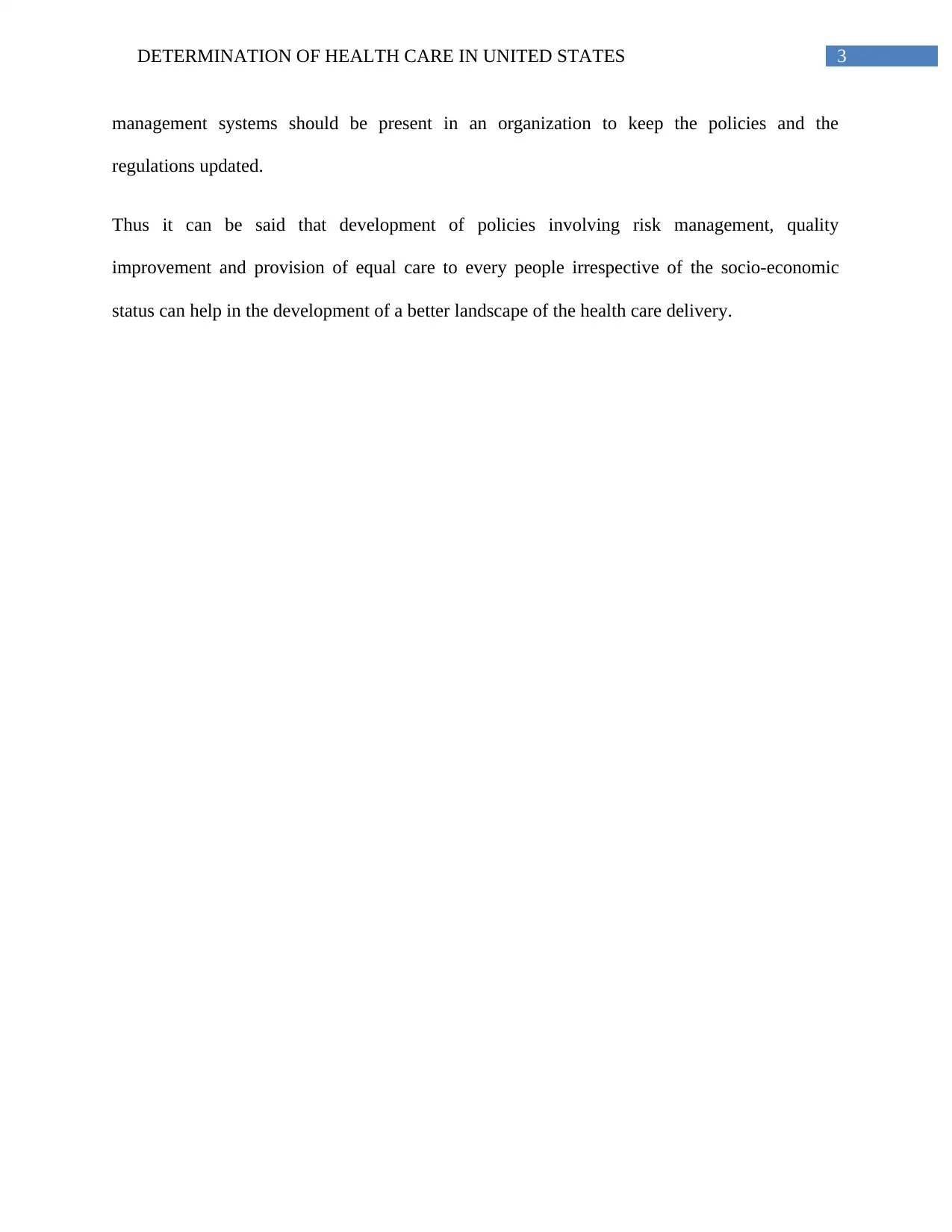
3DETERMINATION OF HEALTH CARE IN UNITED STATES
management systems should be present in an organization to keep the policies and the
regulations updated.
Thus it can be said that development of policies involving risk management, quality
improvement and provision of equal care to every people irrespective of the socio-economic
status can help in the development of a better landscape of the health care delivery.
management systems should be present in an organization to keep the policies and the
regulations updated.
Thus it can be said that development of policies involving risk management, quality
improvement and provision of equal care to every people irrespective of the socio-economic
status can help in the development of a better landscape of the health care delivery.
Paraphrase This Document
Need a fresh take? Get an instant paraphrase of this document with our AI Paraphraser
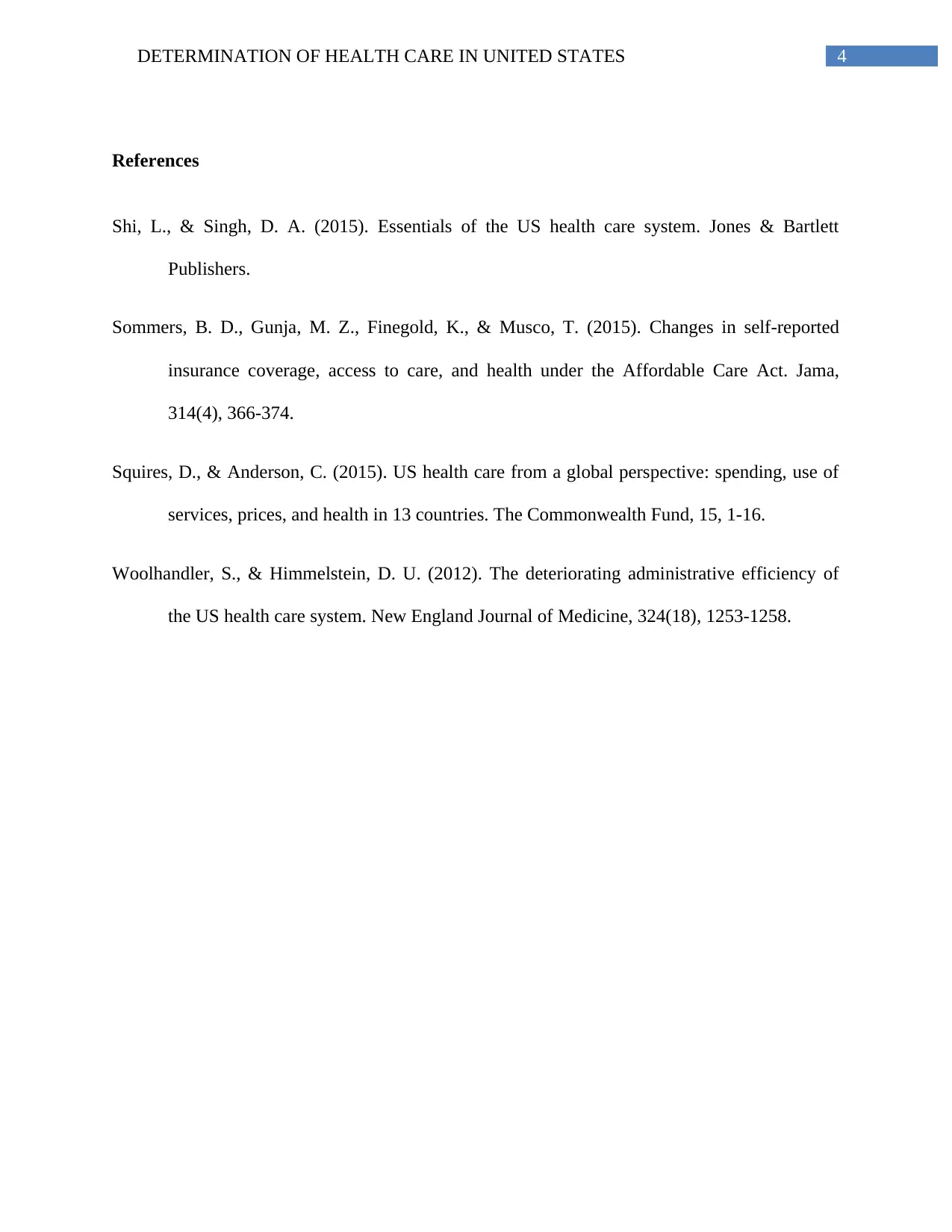
4DETERMINATION OF HEALTH CARE IN UNITED STATES
References
Shi, L., & Singh, D. A. (2015). Essentials of the US health care system. Jones & Bartlett
Publishers.
Sommers, B. D., Gunja, M. Z., Finegold, K., & Musco, T. (2015). Changes in self-reported
insurance coverage, access to care, and health under the Affordable Care Act. Jama,
314(4), 366-374.
Squires, D., & Anderson, C. (2015). US health care from a global perspective: spending, use of
services, prices, and health in 13 countries. The Commonwealth Fund, 15, 1-16.
Woolhandler, S., & Himmelstein, D. U. (2012). The deteriorating administrative efficiency of
the US health care system. New England Journal of Medicine, 324(18), 1253-1258.
References
Shi, L., & Singh, D. A. (2015). Essentials of the US health care system. Jones & Bartlett
Publishers.
Sommers, B. D., Gunja, M. Z., Finegold, K., & Musco, T. (2015). Changes in self-reported
insurance coverage, access to care, and health under the Affordable Care Act. Jama,
314(4), 366-374.
Squires, D., & Anderson, C. (2015). US health care from a global perspective: spending, use of
services, prices, and health in 13 countries. The Commonwealth Fund, 15, 1-16.
Woolhandler, S., & Himmelstein, D. U. (2012). The deteriorating administrative efficiency of
the US health care system. New England Journal of Medicine, 324(18), 1253-1258.
1 out of 5
Related Documents
Your All-in-One AI-Powered Toolkit for Academic Success.
+13062052269
info@desklib.com
Available 24*7 on WhatsApp / Email
![[object Object]](/_next/static/media/star-bottom.7253800d.svg)
Unlock your academic potential
Copyright © 2020–2025 A2Z Services. All Rights Reserved. Developed and managed by ZUCOL.





